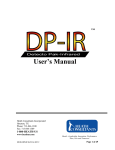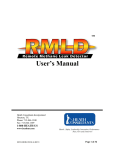Download User Manual PDF - Heath Consultants
Transcript
EI-5 Ethane Identifier User Manual LIABILITY Every care has been taken in the preparation of this document, but Hetek Solutions Inc. does not accept any responsibility for errors or omissions and their consequences. Information in this document is subject to change without notice. This document does not constitute a specification or basis for a contract. Your statutory rights under law are not affected. AREAS OF USE Exposure to certain chemicals can result in a loss of sensitivity of the separation column and semi-conductor sensor. Where such environments are known or suspected it is recommended that more frequent response checks are carried out. Do not use instrument in potentially hazardous atmospheres containing greater than 21% Oxygen. STORAGE, HANDLING AND TRANSIT The instrument is designed to handle harsh environments. If not subject to misuse or malicious damage, the instrument will provide many years of reliable service. Under conditions of prolonged storage the batteries should be removed to prevent any leakage and damaging the instrument. The instrument should be stored in the original carrying case when not in use. TABLE OF CONTENTS INTRODUCTION......................................................................................1 PRINCIPLE OF OPERATION ........................................................................2 INSTRUMENT SPECIFICATIONS ..............................................................4 STANDARD KIT COMPONENTS...................................................................5 OPERATING INSTRUCTIONS .....................................................................6 DATA LOGGING USE ....................................................................................8 INTERPRETING READINGS......................................................................11 TYPICAL ELUTION TIMES .........................................................................12 MANUFACTURER’S RECOMMENDATIONS ..........................................13 CALIBRATION VALIDITY ...........................................................................14 MAINTENANCE INSTRUCTIONS ............................................................15 TROUBLE SHOOTING ..............................................................................16 REPLACEMENT PARTS & ACCESSORIES .............................................17 WARRANTIES AND WARRANTY REPAIR ...............................................18 CUSTOMER ASSISTANCE, MANUFACTURING AND SERVICE LOCATIONS..................................................................................19 INTRODUCTION The Hetek Ethane Identifier, Model EI-5, is a portable, highly sensitive battery operated combustible gas analyzer designed specifically to detect the presence of Ethane in Natural Gas by elution (separation). The Ethane Identifier is a supplementary instrument, used primarily when it is necessary to determine in the field, whether or not a particular combustible indication is the result of escaping utility natural gas or a conflict gas such as naturally occurring methane. Occasionally, it becomes necessary for a gas utility to identify a combustible gas or vapor in the field, to determine whether it is the gas normally distributed by that utility, or perhaps a fermentation gas (marsh gas, landfill gas, soil gas) that is sometimes present in the ground or in sub-surface structures. It has been found that a satisfactory “tracer” in natural gas distribution areas is Ethane. Ethane is usually present in significant concentrations in natural gas, but it is not present in the general run of conflict gases, such as fermentation gases, gasoline and solvents. In many areas, natural gas being distributed is de-ethanized to the level that the Ethane component is not detectable by old style hot-wire instruments. Ethane is being stripped out at the gas fields or scrubbing centres and diverted as a feedstock for the petrochemical industry. However, some residual Ethane still remains in natural gas and this Ethane is readily detectable by highly sensitive instruments such as the Hetek Ethane Identifier. It must be understood that this instrument is not a quantitative instrument and does not replace a Combustible Gas Indicator (C.G.I.). Users should continue to use a Heath Detecto Pak Infrared (DPIR) or Combustible Gas Indicator to locate and measure leaks. Features: • Detects the presence or absence of ethane in less than 2 minutes • Graphical color display • Building data logging • Wrapping memory • One second logging rate, 64000 reads • Carrier gas not required/ Built in pump EI-5 Manual Rev A 1 PRINCIPLE OF OPERATION When the presence of a combustible gas or vapor has been established with a C.G.I., use the Ethane Identifier with the internal pump to draw a sample into the instrument. The valve should be in the “Sample” position. No display indication will occur as the sample is being drawn into the instrument. As the sample is drawn into the instrument, a portion of the sample is trapped inside the instrument in the short sample loop. Switching the valve to “Time” position sends this trapped sample through the separation column where the various components in the sample are separated by their molecular size. The internal pump is used to push the sample through the instrument. If more than one type of combustible component is present in the sample the lightest one (smallest molecule) will be released first followed by the next heavier (larger molecule). These components pass over the sensor in the instrument and are observed visually on a display. If a record of the chromatographic analysis is required the data logger records the date and time and a value at one second intervals. Normally, a full-scale graphical peak will occur for each component but not always, particularly, when low concentrations are being analyzed. The instrument can provide reliable results with sample concentrations measured on a C.G.I. of 800 ppm to 100 LEL natural gas. However, for optimum results attempt to analyze samples in a concentration of about 10 LEL to 75 LEL. To again emphasize the design of the instrument, there is no indication on the display when the valve switch is in the “Sample” position. It is mandatory to use a C.G.I. to determine sample concentration before using the Ethane Identifier. Zeroing the meter exactly at “O” is not critical as the graph may drift during the test. This normally presents little problem to the end result. Electronic Principle: The electrical schematic is based on the semi-conductor type sensor (metallic oxide bead). The Hetek Ethane Identifier uses a semi-conductor type sensor that is pre-determined to be ultra sensitive to the light hydrocarbons. The tough bead of metallic oxide, semi-conductor material, coats itself with oxygen molecules, which is considered EI-5 Manual Rev A 2 the equilibrium condition in clean air. Any substance foreign to clean air disturbs this balance, changing the ion flow in the conductance band of the semi-conductor detects the low concentration and early presence of foreign gases (methane, ethane, propane) rather than giving a quantitative measure of their concentration. As the various components or hydrocarbons elute through the separation column they react on the semi-conductor and the resulting change in electrical resistance is amplified and presented visually on the instrument display. Flow System: The flow system is so arranged that the Ethane Identifier cannot be used as a leak locator. It is set up as a field type gas chromatograph to differentiate between gases by means of a multi-port selector valve, short sample loop and separation column. Valve “Sample” Position: With the selector valve set to “Sample” the sample is drawn into the instrument and fills the short sample loop. Excess sample passes through the sample system and exits through the port on the end of the instrument. The sample does not pass over the sensor in this position so no meter readings occur. Valve “Time” Position: After a gas sample has been drawn into the instrument, the combustible gas is present in the short sample loop. Switching the valve to the “Time” position causes the internal pump to push the sample through the separation column (Chromatograph), over the sensor, and then exhausts it to the outside of the instrument case at the vent port located at the bottom of the instrument. EI-5 Manual Rev A 3 INSTRUMENT SPECIFICATIONS Instrument Weight: 1.3 lbs (0.59 kg) Carrying Case Weight: 7.3 lbs (3.3 kg) Includes Hydrocarbon Filter and accessories. Instrument Dimensions (LxWxH): 8.25 x 4.0 x 1.25 in (21 x 10 x 3 cm) Carry Case Dimensions (LxWxH): 17.5 x 13.5 x 4.5 in (45 x 34 x 12 cm) Sensitivity: EI-5 Manual Rev A 16 PPM C2H6 In Air (Detects Ethane in 800 ppm sample of natural gas which con- tains only 2% Ethane by volume) 4 STANDARD KIT COMPONENTS Carrying case with foam 13” Lexan probe Hydrocarbon filter 3’ Sample hose Downloading software on a CD USB cable The Ethane Identifier has a built in data recorder that can be used to achieve either paper or electronic files for record retention. The data logger records the value, date and time stamp at one second intervals. The software provided is used to download and setup the recorder, this software also has the capability to export the information to Microsoft Excel in both graphical form and table form. The input voltage settings are set at the factory to record the most accurate information for this instrument. Note: Please do not adjust the voltage and time interval for the data logger as this will result in inaccurate logged readings. EI-5 Manual Rev A 5 OPERATING INSTRUCTIONS Basic Ethane Identifier Procedure used in a clean background atmosphere: 1. Switch valve to the “Time” position. 2. Turn on the instrument using the on/off, zeroing switch on the left hand side of the instrument. 3. Let the instrument warm up for a few minutes. This is indicated by the graph on the display decreasing towards zero. 4. Zero the instrument using the zero potentiometer on the left side of instrument. 5. Connect the tubing with the hydrophobic filter in-line to the probe and then connect other end to the instrument port labeled “Inlet”. Take sample. (10 – 75 LEL works best). 6. Switch valve to “Sample” and the pump will draw the sample into the instrument. Only a few seconds is required. 7. Flip the valve to time and begin timing. The first peak should show on the graph in approximately 10 to 25 seconds and then approach the zero point, a second peak (if the sample taken has ethane present) should appear in 30 to 45 seconds. The second peak will be smaller and not last as long as the first methane peak. 8. Leave the valve in the “Time” position and let the instrument clear in a non gaseous environment. 9. Wait 30 seconds after last peak before taking another sample. 10. Turn instrument off. Note: The Hetek Ethane Identifier Model EI-5 should not be used on heavy hydrocarbons. If C4 + hydrocarbons are expected, test for heavy hydrocarbons by using a charcoal filter with your C.G.I. The Hetek Ethane Identifier should only be used to differentiate pipeline natural gas from naturally occurring methane such as marsh gas, swamp gas, landfill gas, soil gas or methane from other sources. Ethane Identifier Procedure in a non clean atmosphere: 1. Connect the hydrocarbon trap to the “Carrier” port on the instrument using the compression fitting. Hand tighten only. 2. Switch valve to the “Time” position. EI-5 Manual Rev A 6 3. Turn on the instrument using the on/off, zeroing switch on the left hand side of the instrument. 4. Let the instrument warm up for a few minutes. This is indicated by the graph on the display decreasing towards zero. 5. Zero the instrument using the zero potentiometer on the left side of instrument. 6. Connect the tubing with the hydrophobic filter in-line to the probe and the other end to the instrument port labeled Inlet. 7. Switch valve to “Sample” and the pump will draw the sample into the instrument. Only a few seconds is required. 8. Flip the valve to time and begin timing. The first peak should show on the graph in approximately 11 to 30 seconds and then approach the zero point, a second peak (if the sample taken has ethane present) should appear in 30 to 75 seconds. The second peak will be smaller and not last as long as the first methane peak. 9. Leave the valve in the “Time” position and let the instrument clear in a non gaseous environment. 10. Wait 30 seconds after last peak before taking another sample. 11. Remove the hydrocarbon trap and store it back in the case with the tubing connected at both ends. 12. Turn instrument off. Hydrocarbon Trap EI-5 Manual Rev A 7 DATA LOGGING USE This data logger will store a reading, date and time, every second. The logger will store 64,000 readings before rewriting over the old information. A USB port on the end of the instrument and the included software will give the user the ability to down load the logged information. This will eliminate the need for an external chart recorder. 1. Install software on a computer according to the quick start guide. 2. Connect the instrument via USB to the computer and open the software. 3. Double click “Setup and start USB data logger”. 4. Keep clicking “Next” then “finish” until the logger has started. EI-5 Manual Rev A 8 Note: Please do not adjust the voltage and time interval for the data logger as this will result in inaccurate logged readings. 5. Disconnect USB cable and proceed with one of the tests procedures outlined above. 6. When sample testing is finished, connect the Ethane Identifier to the computer and start the Easylog software. 7. Double click “Stop the USB data logger and download data” 8. Give the file a name and click save. EI-5 Manual Rev A 9 9. Click “OK” and the data will download and a graph will open automatically. 10. The graph can be exported to Excel along with all the readings in table form. EI-5 Manual Rev A 10 INTERPRETING READINGS Caution: For accurate indications the temperature and humidity of the atmosphere being tested should be approximately the same as that of the instrument. For optimum results attempt to analyze samples at a concentration of about 10 LEL to 75 LEL. If high concentrations above 10% by volume are analyzed, proper separation between components cannot be observed. It may be necessary to take the sample at the fringe area of a suspected pipeline leak rather than at the highest concentration as established with the C.G.I. Note: It is important that the operator of the Ethane Identifier take several tests on their own gas mixture at regular intervals. This will familiarize the operator with the instrument and will provide an elution (separation) pattern for that operator’s particular gas. The times listed on instrument might need to be changed over time as the column ages. A good procedure is to check on a known gas at least once a month or before use. EI-5 Manual Rev A 11 TYPICAL ELUTION TIMES Carrier gas regulator set at 6 P.S.I. Gas Approximate Time Methane 10 - 15 Seconds Ethane 30 - 70 Seconds Propane 3 - 6 Minutes Note: The times shown in the above table is the elapsed times between switching the “Valve” to the “Time” position and the corresponding upscale indications on the display. Note: The material used in the separation column has the property of absorbing and retaining water vapor. Thus the useful life of the separation column is dependent on the amount of moisture present in the gases being analyzed. There may be a need to change the separation column after multiple uses. The instrument should be returned to a qualified service center for column replacement. EI-5 Manual Rev A 12 INSTRUMENT RECOMMENDATIONS Hetek recommends that the instrument be kept clean to the typical standards applied to portable gas detection instruments, as well as meeting the requirements for dust, water and gas resistance that are inherent to most handheld instruments. The use of filters, etc. is covered in the Ethane Identifier User Manual. Of critical importance is the issue of any type of blockage of the gas transfer system, and the assurance of no entrainment of oils, liquids, gases or particulates in the gas sample. Any cleaning protocol would need to address these issues. It is recommended that, should heavy hydrocarbon vapors be drawn into the separation column, the user leave the Ethane Identifier on with the selector valve on “Time” position to purging the column for approximately 30 minutes. The same procedure applies to remove entrapped moisture in the separation column. Calibration of the instrument “sensor” is a misnomer. The instrument utilizes a column that essentially separates the components in a graduated order. If more than one type of combustible component is present in the sample the lightest one (smallest molecule) will be released first followed by the next heavier (larger molecule). The semiconductor reacts to the release of each component, as the column releases it, as shown on the previous page (see Typical Elution Times). Semiconductor sensors cannot be calibrated. There is no mechanism to move their response. So, at best, the semiconductor sensor can be challenged with a known concentration of gas, and the results verified. In the case of the Hetek Ethane Identifier, the response of the semiconductor as an absolute value is not critical – the response time delta or elution times are a function of two separate responses by the sensor. The quantification of the response is not as critical as the time between the two “peaks”. Since the two responses (peaks) by the semiconductor sensor are within a minute of each other, the semiconductor sensor is considered consistent over the time of the evaluation. The closest to calibration that you can come with the Ethane Identifier system is to challenge it with a known sample, within the concentration range noted in the operating manual and check the result. The manual indicates that “the instrument can provide reliable results with sample concentrations measured on a C.G.I. of 10 LEL to 75 LEL natural gas. However, for optimum results attempt to analyze samples in a concentration of about 50 LEL.” EI-5 Manual Rev A 13 CALIBRATION VALIDITY The Manufacturer recommends that the instrument be challenged with appropriate calibration gas and the elution times checked for accuracy on annual basis. Instrument should be returned to a qualified service center annually for verification. EI-5 Manual Rev A 14 MAINTENANCE INSTRUCTIONS Caution: Repair and maintenance beyond that described in this manual should only be performed by qualified personnel. Return to qualified service centre for column replacement. Batteries: If the “Low Battery” LED indicator is solid and bright red, the batteries require replacing. Four (4) “AA” cells power the instrument. Replace the batteries by sliding open the battery access panel at the bottom of the instrument case. Remove old batteries and replace with new batteries. Observe proper polarity! Check condition of new batteries by observing the “Low Battery” indicator. Sensor: The sensor operates at a very low temperature and may never require replacement. The Figaro 2610 sensor can only be calibrated to a range of sensitivity and not to a fixed point. It is advisable to return the unit to an authorized service depot for sensor replacement, as other adjustments may be necessary to match the sensor to the instrument. Separation Column: The separation Column included in the instrument is constructed using Silica Sand. The column should not be disassembled in any way. It is advisable to return the unit to an authorized service center for column replacement. General Maintenance: Keep the instrument clean and preferably stored in the carrying case supplied with the instrument. As with any instrument, extremes of temperatures and humidity should be avoided as much as 10 possible. It is not advisable to leave the instrument in an unheated vehicle night after night in northern climates (winter conditions). Do not subject the instrument to concentrations of heavy hydrocarbons (hexane, gasoline fumes, etc.), as the separation column will become contaminated. EI-5 Manual Rev A 15 TROUBLE SHOOTING Trouble Probable Cause Remedy No indication on meter Check another area of Instrument being used when conducting an known gas concentrain gas-free air analysis tion Methane / Ethane peaks overlap and no down scale display between peaks Methane/ Ethane peak times are not correct Cannot zero EI-5 Manual Rev A Separation column breakdown Sample tested in a methane background Gas concentration too high Replace separation column Connect Hydrocarbon filter Take test at location of lower concentration or dilute the samples Return instrument to a Column assembly has Hetek authorized rebecome contaminated pair facility for column replacement Batteries weak Replace batteries 16 REPLACEMENT PARTS & ACCESSORIES The following parts are recommended as replacement parts for the Ethane Identifier Model EI-5. Ethane Identifier Complete 104294 Ethane Identifier - Instrument Only 104293 Carry Case Regular c/w Foam 104305 CD, Manual with software 104308 Probe, 13” Lexan104304 Tubing 1/8” x 1/4” Per Foot 104303 ACCESSORIES The following parts are not supplied with the instrument but are available as accessories if required. Hydrocarbon Filter104299 Hydrocarbon Refill Material 104298 30” Brass Probe w /Filter 104297 30” Lexan Probe w / Filter 104296 EI-5 Manual Rev A 17 WARRANTIES AND WARRANTY REPAIR All instruments and products manufactured by the Heath Consultants Incorporated are warranted to be free from defects in material and workmanship for one (1) year from the date of shipment. Furthermore, the warranty on authorized repairs in Houston FSC and regions is ninety (90) days materials and thirty (30) days labor. This repair warranty does not extend any other applicable warranties. Our warranty covers only failures due to defects in materials or workmanship, which occur during normal use. It does not cover failure due to damage which occurs in shipment, unless due to improper packing, or failures which result from accident, misuse, abuse, neglect, mishandling, misapplication, alteration, modification or service by anyone other than a Heath warranty repair location. Battery and damage from battery leakage and all expendable items such as filters and Plunger Bar rods are excluded from this warranty. Also, O-rings, gaskets and seals for the Petro-Tite product line are excluded from warranty coverage. In addition “wetted” parts in various Petro-Tite products are warranted for 30 days only. Heath’s responsibility is expressly limited to repair or replacement of any defective part, provided the product is returned to an authorized warranty repair location, shipping charges pre-paid and adequately insured. Return shipping charges and insurance will be paid by Heath warranty expense. We do not assume liability for indirect or consequential damage or loss of any nature in connection with the use of any Heath product. There are no other warranties expressed, implied or written except as listed above. The following suggestions will expedite the repair of your instrument: • Package carefully, using the original shipping carton, if available, return all components. • Specify your complete shipping and billing addresses. • Specify the instrument or product name, model number and serial numbers on all correspondence. • Include a brief description of the problem you are experiencing and specify person to be contacted for information. EI-5 Manual Rev A 18 CUSTOMER ASSISTANCE, MANUFACTURING AND SERVICE LOCATIONS CORPORATE HEADQUARTERS Consultants Incorporated 9030 Monroe Road Houston, Texas 77061 Phone: (713) 844-1300 Fax: (713) 844-1309 MANUFACTURING AND WARRANTY SERVICE CENTERS Heath Consultants Factory Service Center 9030 Monroe Road Houston, Texas 77061 Phone: (713) 844-1350 Fax: (713) 844-1398 EI-5 Manual Rev A 19 Heath Consultants Incorporated operates under a continual product improvement program and reserves the right to make improvements and/or changes without prior notification. Heath Consultants Incorporated Houston, TX 713-844-1300 Fax: 713-844-1309 1-800-HEATH-US www.heathus.com Safety, Leadership, Innovation, Performance ...Then, Now and Tomorrow
































